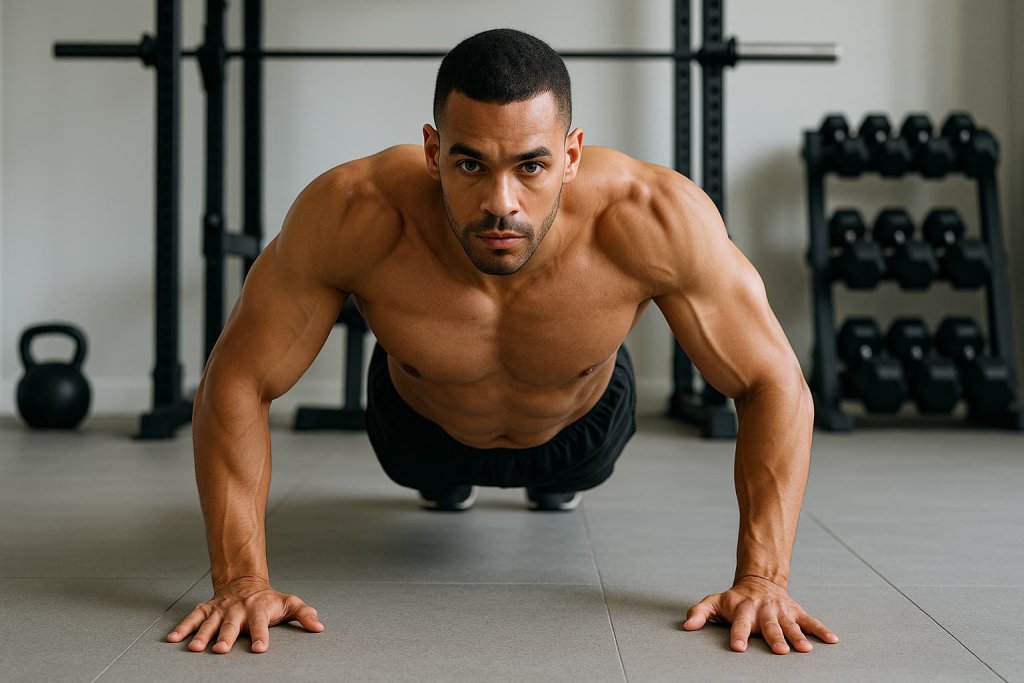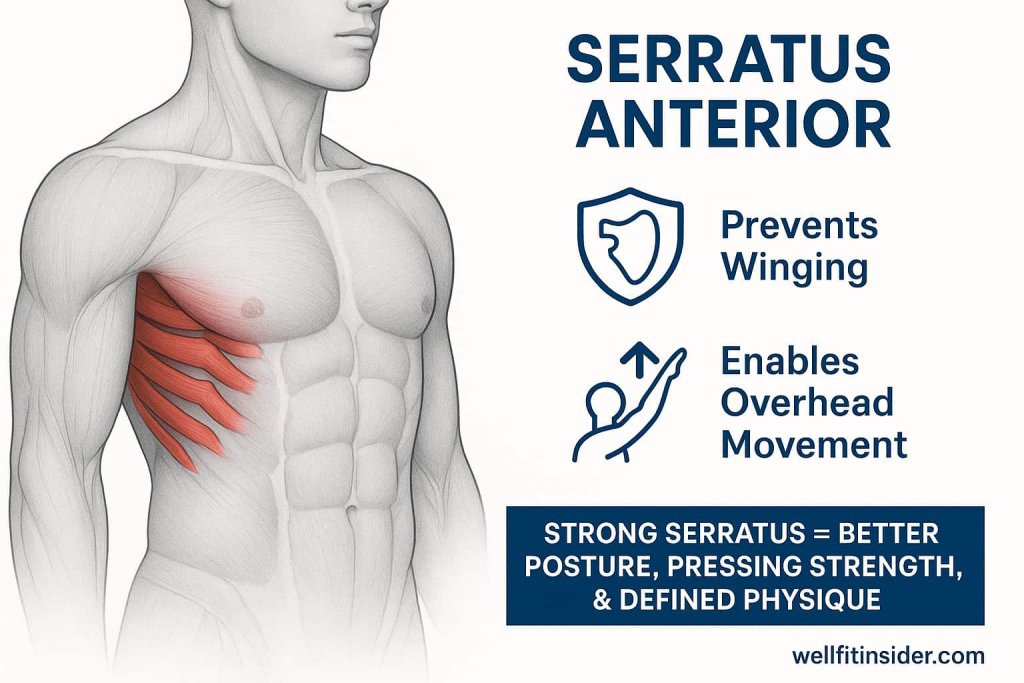The best serratus anterior exercises are the “push-up plus,” wall slides, and serratus punches—these moves deliver the most muscle activation and visual definition, according to sports science and top trainers. If you want defined, athletic shoulders and a strong, stable upper body, targeting your serratus anterior is essential.

Training the serratus anterior is often overlooked, but it’s crucial for anyone who wants full upper-body strength, a balanced physique, and pain-free movement. In this guide, you’ll learn exactly what the serratus anterior does, why it matters, and how to train it using the 10 best exercises—all backed by the latest research and trainer experience.
For more info, check out the ACE scapular strengthening resource for additional science-based insights.
What Is the Serratus Anterior? (And Why Should You Train It?)

The serratus anterior is a thin, fan-shaped muscle along your upper ribs, wrapping under your armpit and attaching to your shoulder blade (scapula). It has two essential roles:
- Stabilizes the shoulder blade: Prevents “winging” and keeps your scapula flush to your ribcage.
- Controls scapular movement: Allows overhead arm movement and proper push mechanics (like in bench press, push-ups, and overhead presses).
Why it matters:
A weak serratus can cause poor posture, shoulder impingement, upper back pain, and a telltale “winged” shoulder blade. Strong serratus anterior is linked to improved bench pressing, overhead lifts, and a sharper, more defined look just below the chest (often called “boxer’s muscle”).
Recent studies (PubMed, 2020) confirm: people with weak serratus often struggle with rotator cuff injuries and instability.
The 10 Best Serratus Anterior Exercises (Trainer & Science Backed)
The serratus anterior is the muscle that “wraps” around your ribcage, helping to protract and stabilize your shoulder blades. A strong, active serratus is essential for pain-free pressing, overhead strength, and that “sculpted” look along your sides.
The following exercises are ranked by EMG studies, trainer feedback, and real-world results for all levels—from rehab to advanced strength.
1. Push-Up Plus
Why it’s:
The push-up plus achieves the highest EMG activation of the serratus anterior of any bodyweight exercise (JOSPT, 2006). The “plus” phase—the extra reach at the top—directly trains scapular protraction, the main function of the serratus.
How to do it:
- Start in a classic plank or push-up position, hands under shoulders.
- Lower down as you would in a normal push-up.
- At the top, push your upper back toward the ceiling by spreading your shoulder blades apart (“plus” phase).
- Keep elbows locked as you push further—don’t bend arms for the plus!
- Repeat for 10–15 slow, controlled reps.
Trainer Tips:
- Do not shrug your shoulders toward your ears; keep your neck long.
- Maintain a straight line from head to heels; don’t sag hips.
- Pause and feel the upper back at the top—this is where the serratus works hardest.
Programming:
Ideal for warm-ups, corrective routines, and finisher sets after chest or shoulder training.
2. Scapular Push-Ups
Why it’s great:
Scapular push-ups isolate the serratus by only moving the shoulder blades, not the arms. Excellent for beginners, those rehabbing shoulders, or as activation before pressing.
How to do it:
- Assume a plank position, elbows locked.
- Without bending your arms, let shoulder blades pinch together (retraction).
- Then, push away from the floor, spreading your shoulder blades (protraction).
- Move slowly for 12–20 strict reps.
Modifications:
- Do from knees or incline (hands on bench/wall) for easier versions.
Trainer Tips:
- Focus on full range—pinch and spread.
- Avoid arching or sagging your lower back.
Programming:
Use as a daily activation drill, especially before any pushing exercise.
3. Wall Slide (or Wall Push-Up Plus)
Why it’s science-backed:
Wall slides activate the serratus through upward rotation, essential for overhead health (PubMed). Ideal for those with shoulder pain or limited mobility.
How to do it:
- Stand facing a wall, forearms flat against it, elbows bent.
- Slide arms up the wall as high as possible, keeping forearms in contact.
- At the top, reach your shoulder blades upward and outward.
- Lower slowly and repeat 12–15 times.
Trainer Tips:
- Don’t arch your low back—brace your abs.
- Avoid shrugging shoulders up; keep neck relaxed.
Modifications:
Add a mini resistance band around forearms for more challenge.
4. Serratus Punch
Why it works:
The “punch” directly trains serratus protraction, using bands or dumbbells to add resistance. Safe and effective for all levels.
How to do it:
- Hold a light dumbbell or resistance band.
- Lie on your back (floor or bench) or stand.
- With arm straight, “punch” toward the ceiling (or forward) so your shoulder blade lifts away from the floor.
- Pause, then lower slowly. 10–15 reps per arm.
Trainer Tips:
- Focus on moving the shoulder blade, not just the arm.
- Don’t let your lower back arch if lying down.
Programming:
Works well as a rehab or prehab drill.
5. Dynamic Hug
Why it’s special:
A “hugging” motion, especially with a cable or band, recruits the serratus and chest better than most presses (MedBridge, 2023).
How to do it:
- Stand tall, band anchored behind you at chest height.
- Hold band, arms open wide, elbows slightly bent.
- Bring arms together in front as if giving a big hug, protracting shoulder blades.
- Squeeze at the end, return slowly. 12–15 reps.
Trainer Tips:
- Don’t arch your back—brace your abs.
- Keep movement slow and controlled.
Programming:
Use as part of chest or shoulder routines, or as a corrective exercise.
6. Scaption with External Rotation
Why it’s trainer-approved:
Scaption (raising arms in the scapular plane) with external rotation is shown in EMG research to strongly activate both serratus and rotator cuff (MedBridge, 2023).
How to do it:
- Stand, dumbbells at sides, palms facing in, thumbs up.
- Raise arms at a 30–45° angle from the body (not straight forward), to shoulder height.
- Lower slowly. 10–15 reps.
Trainer Tips:
- Use very light weights—quality over quantity.
- Don’t shrug shoulders or arch back.
Programming:
Ideal for shoulder health, warm-up, or mobility circuits.
7. Ab Rollout (or Overhead Wall Rollout)
Why it’s advanced:
Full extension rollouts require serratus control to keep the ribcage down and shoulder blades stable. Great for core and scapular strength.
How to do it:
- Kneel with an ab wheel, or stand facing a wall with a towel under your hands.
- Slowly roll the wheel forward or slide hands up the wall, reaching overhead.
- “Push away” with shoulders at full extension, then return.
- Repeat for 8–12 reps.
Modifications:
If too hard, limit range or do wall rollouts.
Trainer Tips:
- Keep abs tight—don’t let low back sag.
- Move slowly, no jerking.
Programming:
Use as a core finisher or advanced serratus drill.
8. Band Chest Press with Forward Reach
Why it’s functional:
Adding a “reach” at the end of a band chest press mimics the punch, amplifying serratus involvement.
How to do it:
- Anchor band behind you at chest height.
- Press forward with one arm, then reach further at the end, letting shoulder blade move.
- Return slowly, alternate arms. 12–15 reps per side.
Trainer Tips:
- Don’t twist torso.
- Focus on the scapula moving “around the ribcage.”
Programming:
Great for fighters, athletes, or anyone wanting strong, pain-free pressing.
9. High Bear Crawl
Why it’s unique:
Bear crawls require the serratus to stabilize the scapula under a moving, loaded core—amazing for functional strength.
How to do it:
- Start on all fours, hands and toes, knees bent and hovering.
- Crawl forward, keeping hips low and shoulder blades spread.
- Go for 20–40 seconds or 10–15 steps.
Trainer Tips:
- Keep core braced, avoid hip “sway.”
- Move slow and controlled, not rushed.
Programming:
Add to warm-ups, athletic training, or circuits.
10. Diagonal Shoulder Walks
Why it’s a finisher:
Diagonal walks with dumbbells challenge the serratus to stabilize and control scapula through full range, improving mobility and “cuts”.
How to do it:
- Stand, light dumbbell in each hand.
- Lift one arm diagonally overhead, lower, alternate sides.
- Move slow and deliberate for 10–15 reps per arm.
Trainer Tips:
- Don’t let torso rotate—stay tall.
- Use light weights.
Programming:
Great for upper-body mobility days or as a finishing move.
Serratus Anterior Workout Structure & Programming
How Often:
Train your serratus 2–3 times per week for best results, ideally in your warm-up or at the end of upper body workouts.
Sample Routine:
- Activation: Wall Slide – 2 sets of 15
- Strength: Push-Up Plus – 3 sets of 10
- Stability: Serratus Punch – 2 sets of 12
- Dynamic Integration: High Bear Crawl – 2 x 30 sec
Progression Tip: Start with activation drills, progress to loaded or dynamic movements as you get stronger and more coordinated.
Science-Backed Pro Tips
- Quality beats quantity: Perform all moves slowly, focus on scapular motion (not just arm movement).
- Don’t over-shrug: Serratus exercises should not create neck tension—if you feel it, reset your form.
- Watch for winging: If your shoulder blade sticks out, increase volume of activation drills (like wall slides and scapular push-ups).
- Combine for best results: Research suggests blending static (wall slides), loaded (serratus punch), and dynamic (bear crawl) moves gives the most complete serratus development (PubMed, 2020).
Common Questions
How do I know if my serratus is weak?
Signs include:
- Shoulder blade winging
- Poor overhead strength
- Shoulder discomfort or pinching
- Loss of “chiseled” appearance under the chest
How quickly will I see results?
Most people notice improved shoulder stability, posture, and definition within 2–4 weeks of targeted training.
Is this for beginners or advanced lifters?
Both! Wall slides, scapular push-ups, and punches are perfect for beginners, while ab rollouts and high bear crawls challenge even athletes.
Key Benefits of Serratus Anterior Training
- Injury Prevention: Reduces risk of rotator cuff and impingement issues.
- Posture & Aesthetics: Enhances chest/shoulder definition for a “boxer’s muscle” look.
- Strength Gains: Improves pressing strength and overhead power.
- Functional Movement: Supports healthy, pain-free range of motion in daily life and sports.
Conclusion
Strong serratus anterior muscles deliver healthy shoulders, powerful lifts, and that distinctive athletic cut. Make these exercises part of your routine 2–3 times a week for visible, lasting results—whether you’re training for performance or looks.
Authoritative References
- ACE Fitness: Scapular Strengthening
- NCBI: Serratus Anterior and Shoulder Pain (2020)
- JOSPT EMG study: Serratus Activation in Push-Ups (2006)
- Wall Slide for Serratus Activation (2023)
- MedBridge – Serratus Exercises for Shoulder Health (2023)
- Wikipedia – Serratus Anterior Muscle
